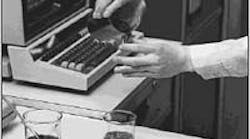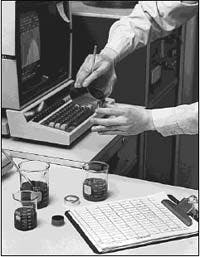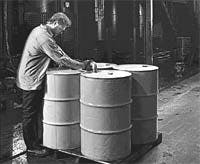Recycling. Reclaiming. Exactly what do they mean? Is there a difference between the two terms? When discussing hydraulic oils there seems to be some confusion as to what reclaiming means and what reclaiming does to the oil. Can reclaiming make the oil as good as new? Does it take out all of the additives? Can water-based fluids be reclaimed? This article addresses these and other important questions regarding hydraulic fluid reclamation.
Reclaiming fluids
Terminology is important when referring to recycling. Today, recycling has become a generic term. For our purposes, recycling takes a dirty oil and filters it to a prescribed cleanliness for re-use. Reclaiming, on the other hand, not only cleans the oil, but restores the base stock and additives to new or as-new condition.
The first phase of reclaiming involves gravity settling, which eliminates water and dirt. The use of a centrifuge speeds up settling considerably.
Oil is then chemically treated with compounds called adsorbents. These adsorbents remove unwanted elements from the oil. This part of the process is time consuming, because each oil requires a different solution and must be tested throughout processing to ensure satisfactory results.
Test results then determine what additives are required to bring the oil back to the proper specifications. When the entire process is complete, the oil is returned in like-new condition, having protection and lubrication properties necessary for the system. The small amounts of solid byproducts are disposed of according to EPA regulations by the reclaimer. So instead of coping with used-oil disposal problems, you just continue to reclaim the oil.
The first step in reclaiming hydraulic fluid actually begins with the design of the system. Each system should contain inlet filtration elements. Without filters, clean fluid entering the system can become contaminated. In fact, even newly reclaimed oil or new oil — that has not even been run through a system — should be filtered before putting it into your system. While it may appear clean, the smallest particles from open air can contaminate the oil. The reclaiming process becomes less effective if a system does not have a filtration process in place.
Types of hydraulic fluids
Before reclaiming of hydraulic fluids can be explored, we must first highlight the different types of fluids and their advantages. Depending on system environments, different types and grades of hydraulic oil are recommended. General guidelines are provided by pump manufacturers who recommend certain grades for each of their models. These guidelines should be followed as closely as possible. For instance, the use of a high-viscosity oil in a system where a lower viscosity fluid is recommended invites problems. If the oil is too thick, it could starve the pump, causing cavitation and eventually premature failure of the pump. Many times, a surefire symptom of pump cavitation is iron particles in the fluid. The iron is from pump wear. Some companies may go through three or four pumps before realizing they are using the wrong fluid. All this could have been avoided if the proper oil grade had been installed originally.
There are four basic types of hydraulic fluids:
- petroleum-based
- synthetic
- fire-resistant, and
- environmentally-friendly fluids.
Some of these fluids are oil-based, while others contain very little oil. While this article will not get into detail about these fluids, it is important to note that different tests and reclaiming methods are required for each type of fluid because of the difference in oil and water contents.
Petroleum and synthetic oils, phosphate esters and polyol esters use a similar reclaiming process. However, again, the quality of the oil is important. It doesn’t matter which reclaiming method is used, reclaiming of these oils can only return the quality to their original quality. A sub-par fluid can’t be improved by reclaiming.
Water glycols require special processing. Care should be taken that in addition to being clean, the viscosity and alkaline reserve are in specification on the reclaimed product. Some companies that supply new glycols –– in addition to a number of reclaimers –– do provide this service. High-water-based-type fluids are not normally reclaimed due to certain technical and economic considerations. Since environmentally friendly fluids are normally used where leakage into the environment is expected, they are not collected for reclamation.
How does reclamation affect additives?
Most hydraulic fluids have additives that not only lengthen the life of the fluid, but also inhibit formation of rust and oxidation. Rust causes abrasive wear, clogs valves, and causes general malfunctions. Oxidation can cause varnishing on components, which eventually leads to major problems and replacement of expensive system components. So it is important to know what happens to the additives in a fluid when it is reclaimed.
The bulk of hydraulic fluid is oil; additives only make up 0.5% to 4% of the fluid. There are three types of oil:
- parafinic
- napthenic, and
- aromatic
Additives are most effective in parafinic oils, but napthenic oils are less expensive. The problem with napthenic oils is that without severe hydrotreating they have been found to be possibly carcinogenic. This extra step has added to the cost. Aromatic oils, used primarily as processing oils in the rubber industry, have labeling that suggests possible toxic components. It is important to remember that the oil does not wear out, but if the additives are working, they wear out. The “worn out” part of the additive must be removed before any additives are replaced. Any additives that were originally added to the fluid must also be added after the fluid is reclaimed.
Testing hydraulic fluids
The main reason to test hydraulic fluid is to find out if it can continue to be used in the system. Tests are conducted to see how much dirt is in the oil; the concentration and type of contamination (iron, copper); and how much component wear. For instance, tests can determine the amount of iron and copper in the oil. High iron generally indicates pump wear. High copper content is a sign of bushing wear. Excessive component wear can be an indication of the wrong type or grade of fluid being used.
Tests are also run on new or reclaimed oil to see if the quality does indeed meet set specifications. Finally, tests also indicate which reclaiming method would be best to use on the fluid.
There are several tests that allow us to examine the cleanliness of the oil. One of these is not just by looking at the oil. Even if it looks brand new, there could be high contamination levels. You cannot determine the contamination level of hydraulic fluids simply by looking at them.
Acid (neutralization) number tests measure lubricant breakdown or additive content. If results from this test are poor, simple filtration or centrifuging will not correct the problem. Chemical treatment or additive changes are required.
Metal analysis confirms additive levels in many anti-wear and extreme pressure lubricants. Trace metals track wear or contamination. However, metal analysis can't determine the additive's condition and more testing is necessary.
One of the more common testing procedures is the particle count or millipore test, which determines the degree of cleanliness. It 's also used to see if the cleaning method chosen worked. A major advantage of millipore testing is that analysis of the millipore patch can aid in identifying the type of contaminant.
Water content tests should be able to test for amounts down to a tenth of a percent as higher amounts can cause problems; flash point tests determine solvent contamination; and RBOT tests tell users the remaining R&O additive content and life remaining in the lubricant base.
Reclaiming methods
After conducting tests, the proper reclaiming method can be implemented. The tests reveal what contamination problems exist in the hydraulic fluid. Depending on the problem, one of four methods can be used.
Mechanical means are the simplest, most inexpensive way of treating the oil. The obvious initial method is filtration. While this should already be implemented, it is shocking how many systems actually don’t use filtration methods. Filtration limitations include low volume and limited quality. A second mechanical method is centrifuging. This can only be done for jobs in large volume, however. In addition to high operating costs, centrifuge provides limited quality. It is important to note that mechanical methods do just one thing: they remove dirt. They don’t recondition the oil or change it in any way.
Chemical reprocessing uses adsorption and reducing agents to attract acidic byproducts, change them to salts, and filter them out. Competitively priced, chemical reprocessing provides good quality results.
Re-refining the hydraulic fluid involves distillation or distillation/hydrotreating. These methods lose all the additives to make a base stock. Again, remember that the oil doesn’t break down but the additives do. This returns the hydraulic fluid to the same grade and specifications as new. Re-refining, however, can only be used for large-quantity jobs.
Electrostatic filtration can remove charged oil soluble contaminants from hydraulic oil. This is important as this type of contaminant is what causes varnishing and build-up on hydraulic components. The method, however, is limited to lower viscosity fluids that do not contain water. A combination of reclaiming methods probably will be required to yield the needed quality for a particular hydraulic system.
Fluid recovery has always been a problem in the hydraulics industry. With environmental considerations becoming more and more important, reclaiming hydraulic fluids just might be the solution to the problem.
William Stofey is president of American Ultra Specialties Inc., Hudson, Ohio, which specializes in oil reclamation.



